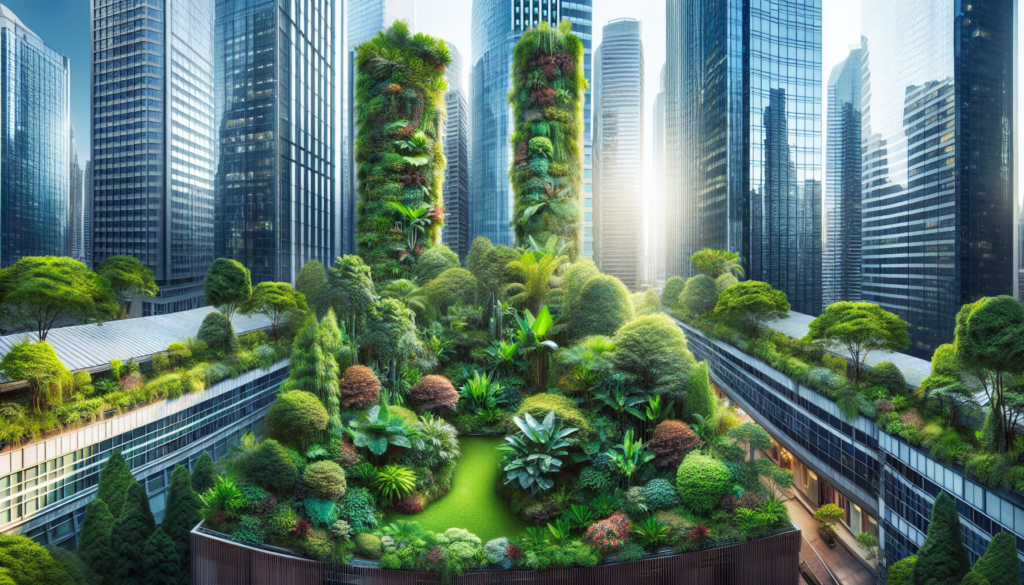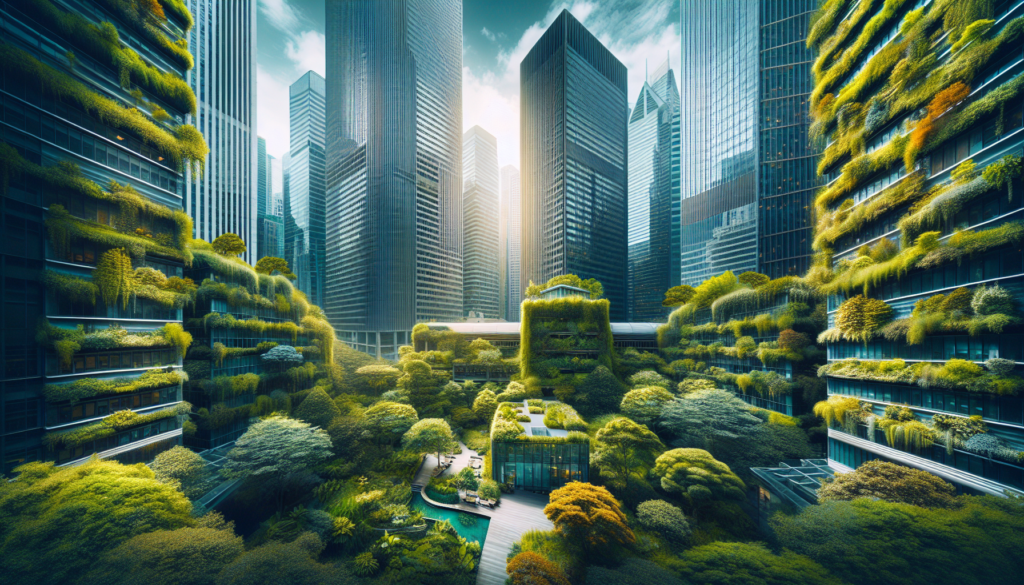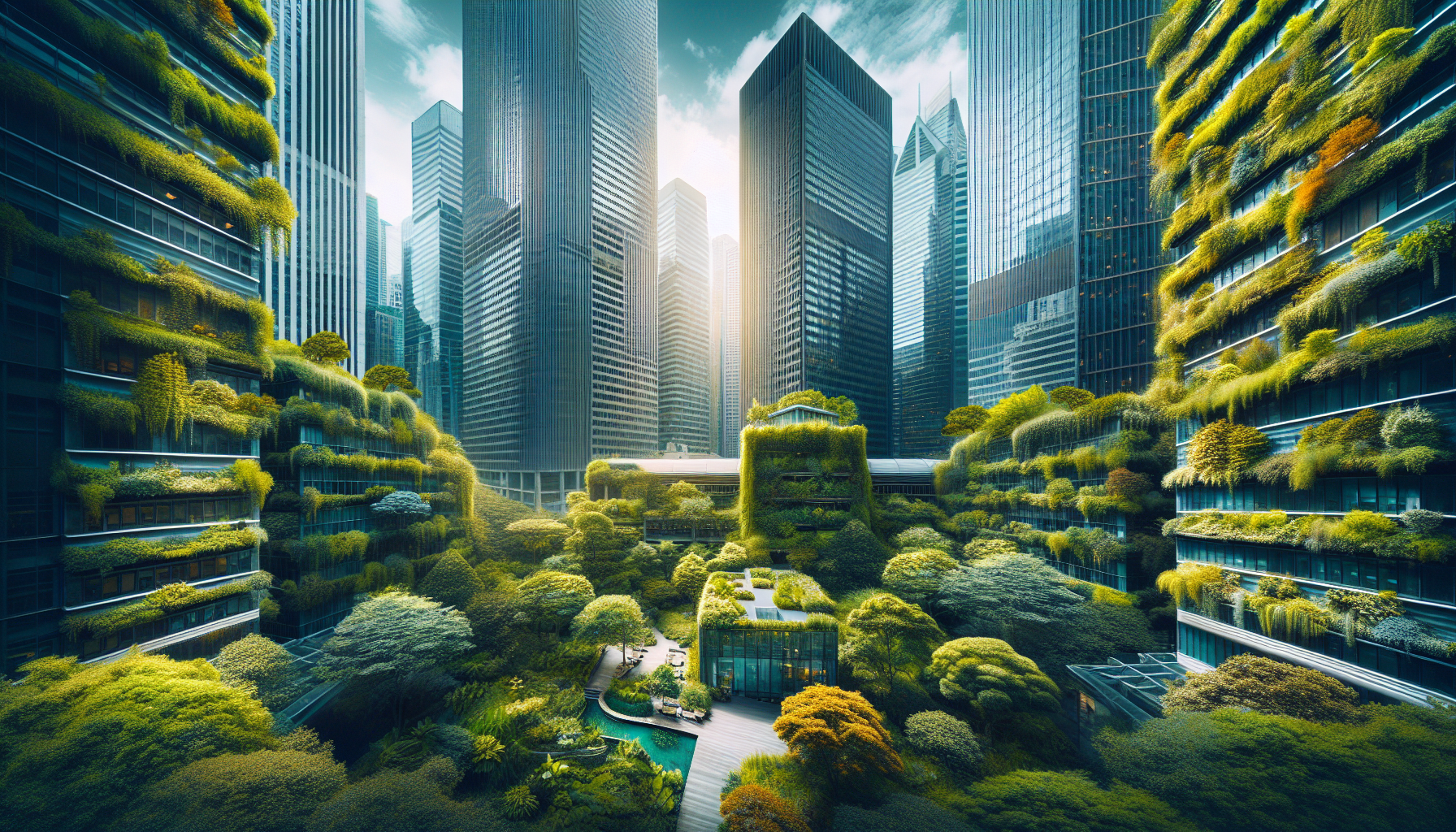In today’s fast-paced urban lifestyle, it’s easy to overlook the significance of green spaces in our cities. However, these pockets of nature play a vital role in enhancing our overall well-being and connecting us with the environment. From providing a refreshing escape from the concrete jungle to improving the quality of air we breathe, green spaces have a profound impact on our physical and mental health. Furthermore, they encourage social interactions and foster a sense of community, transforming cities into vibrant, livable spaces. Understanding the importance of green spaces is crucial for creating sustainable and healthy urban environments for generations to come.
Improving Air Quality
Green spaces play a crucial role in improving air quality by filtering pollutants. Trees and plants are known to absorb harmful gases such as carbon monoxide, sulfur dioxide, and nitrogen oxide, which are commonly emitted from vehicles and industrial activities. These pollutants can pose serious health risks, especially to individuals suffering from respiratory conditions. By acting as natural filters, green spaces help to remove these pollutants from the air, making it cleaner and healthier to breathe.
In addition to filtering pollutants, green spaces also contribute to absorbing carbon dioxide, one of the main greenhouse gases responsible for climate change. Through a process called photosynthesis, plants absorb carbon dioxide from the atmosphere and convert it into oxygen. This not only helps to mitigate climate change but also improves air quality by reducing the concentration of carbon dioxide, which can be harmful when present in high levels.
The process of photosynthesis not only absorbs carbon dioxide but also releases oxygen into the atmosphere. Trees, in particular, are excellent oxygen producers, with a single mature tree capable of releasing enough oxygen to sustain two human beings. By increasing the number of trees and plants in urban areas, green spaces help to replenish the oxygen levels and create a healthier environment for both humans and wildlife.
Another important contribution of green spaces in urban areas is their ability to reduce the urban heat island effect. Cities tend to have higher temperatures compared to surrounding rural areas due to the large concentration of concrete and asphalt, which absorb and retain heat. This phenomenon can result in increased energy consumption for cooling purposes and has detrimental effects on human health. However, the presence of green spaces, such as parks and gardens, can help to mitigate the urban heat island effect by providing shade, reducing surface temperatures, and cooling the surrounding environment.
Promoting Mental and Physical Health
Green spaces offer numerous benefits for mental and physical well-being. One of the key advantages is the ability of green spaces to reduce stress and anxiety. Spending time in nature has been shown to have a calming effect on the mind, helping to reduce the production of stress hormones and promote relaxation. Whether it’s taking a stroll through a park or simply sitting under a tree, being surrounded by greenery can provide a much-needed escape from the stresses of daily life.
In addition to reducing stress, green spaces also have a positive impact on mood and well-being. Researchers have found that exposure to nature, even for a short period, can improve mood and increase feelings of happiness and joy. Green spaces offer a peaceful and serene environment that allows individuals to connect with nature and find solace from the hustle and bustle of city life.
Furthermore, green spaces support physical fitness by providing opportunities for outdoor activities. Parks and recreational areas offer spaces for jogging, cycling, walking, and various sports, encouraging individuals to engage in physical exercise. Regular physical activity has numerous health benefits, including reducing the risk of chronic diseases, improving cardiovascular fitness, and enhancing overall well-being.
Moreover, spending time in green spaces has been linked to a boost in the immune system. Research has shown that exposure to nature and fresh air can strengthen the immune system, making individuals less susceptible to various illnesses. Additionally, the presence of trees and plants in urban areas helps to purify the air, reducing the likelihood of respiratory problems and other health issues associated with poor air quality.

Enhancing Biodiversity
Green spaces are essential for enhancing biodiversity in urban environments. By providing habitat for wildlife, such as birds, insects, and small mammals, green spaces support the presence of diverse species within cities. These pockets of nature create important stepping stones for wildlife, allowing them to move and thrive in an often fragmented urban landscape.
Furthermore, green spaces promote ecological balance by creating a network of interconnected habitats. This interconnectedness is vital for wildlife to find food, shelter, and suitable breeding sites. Green spaces, especially those designed with native plants, offer a variety of food sources and nesting opportunities for birds, butterflies, bees, and other pollinators. By supporting the needs of different species, green spaces contribute to maintaining a healthy and balanced ecosystem within urban areas.
The presence of green spaces in cities is particularly crucial for supporting pollinators. Bees, butterflies, birds, and other pollinators are essential for the pollination of plants, including many food crops. Without the presence of these pollinators, the availability and diversity of fruits, vegetables, and nuts would be greatly reduced. Therefore, by providing a suitable habitat and food sources, green spaces play a vital role in ensuring the survival and abundance of pollinators, ultimately benefiting the overall ecosystem and food production.
Moreover, green spaces help to preserve endangered species by providing refuge and protection for threatened plants and animals. Urban areas, with their expansion and destruction of natural habitats, often pose significant challenges to the survival of many species. However, strategically located green spaces can offer a sanctuary for these endangered species, allowing them to persist and recover their populations. By preserving and protecting these areas, cities can contribute to global conservation efforts and help prevent the loss of biodiversity.
Improving Water Management
Green spaces have a significant impact on improving water management within urban areas. One of the key benefits is their ability to prevent flooding by acting as natural sponges. The soil and vegetation in green spaces can absorb rainfall, reducing the volume of stormwater runoff that would otherwise overwhelm drainage systems and cause flooding. This natural flood mitigation helps to protect both property and infrastructure, reducing the risks and costs associated with flood damage.
Additionally, green spaces play a vital role in filtering and purifying water. As rainfall infiltrates the soil and percolates through the roots of plants, contaminants and pollutants are removed, improving the quality of groundwater and reducing the risk of water pollution. Moreover, green spaces function as natural filters for stormwater runoff by trapping sediments, nutrients, and chemicals before they enter water bodies. This helps to maintain the health and integrity of rivers, lakes, and streams, benefiting both humans and aquatic ecosystems.
Another crucial aspect of water management that green spaces contribute to is the recharge of groundwater. As rainwater seeps into the soil, it replenishes underground water sources, ensuring a sustainable supply of freshwater. With the increasing demands for water in urban areas, especially during periods of drought, the ability of green spaces to recharge groundwater becomes even more important. By preserving and expanding green spaces, cities can enhance their water resources and reduce their reliance on external water supplies.

Enhancing Social Interaction and Community Connection
Green spaces serve as important venues for social interaction and community connection within cities. By providing areas for gathering and recreation, green spaces encourage social cohesion and foster a sense of belonging among residents. People of different ages, backgrounds, and cultures can come together in these shared spaces, promoting social integration and cultural exchange.
Furthermore, green spaces offer meeting places for various community activities and events. Parks and gardens can be used for picnics, concerts, sports competitions, and festivals, providing opportunities for people to connect, interact, and celebrate together. These community gatherings not only strengthen social ties but also contribute to the overall vibrancy and diversity of urban life.
The presence of green spaces is particularly crucial in densely populated areas where access to nature is limited. By providing easily accessible and well-maintained green spaces, cities can ensure that all residents have the opportunity to experience and enjoy the benefits of nature. This inclusivity promotes equality and equity, making green spaces a powerful tool for addressing environmental justice and creating more equitable urban environments.
Boosting Property Values and Economic Benefits
Green spaces have a positive impact on property values and contribute to various economic benefits within cities. Numerous studies have shown that proximity to green areas, such as parks or tree-lined streets, can increase real estate prices. Homebuyers often express a willingness to pay a premium for properties located near green spaces due to the added aesthetic value and improved quality of life associated with such areas.
In addition to increasing real estate prices, green spaces attract businesses and investments to urban areas. Companies often consider the presence of green spaces when choosing their location, as these areas provide a more attractive and appealing environment for both employees and customers. Furthermore, businesses operating in or near green spaces may experience increased patronage and customer satisfaction, resulting in economic growth and prosperity for the surrounding community.
Green spaces also contribute to promoting tourism and recreation, which in turn bring economic benefits to cities. Visitors are often drawn to cities that offer an abundance of green areas and natural attractions. Parks, botanical gardens, and other green spaces provide opportunities for tourists to relax, explore, and engage in various recreational activities. This influx of tourists stimulates local economies by generating revenue for hotels, restaurants, and other businesses, thus creating jobs and supporting the overall economic vitality of the city.
Moreover, green spaces can help to reduce infrastructure costs in cities. By incorporating green design principles, such as the use of vegetation, permeable surfaces, and natural drainage systems, cities can minimize the need for costly stormwater management infrastructure. Instead of relying solely on conventional engineering solutions, green spaces provide a more sustainable and cost-effective approach to managing stormwater runoff and improving water quality.
Mitigating Noise Pollution
Green spaces play an important role in mitigating noise pollution within urban areas. Trees and vegetation act as natural sound barriers, absorbing and dampening noise from surrounding sources such as traffic, construction, and industrial activities. The leaves, branches, and trunks of trees help to break up sound waves and prevent the reflection and propagation of noise, resulting in a quieter and more peaceful environment.
The presence of green spaces also allows for the creation of sonic barriers, especially when strategically planted along busy roads or near noisy infrastructure. These barriers effectively block out or reduce the transmission of noise, protecting nearby residential areas from excessive noise pollution. By providing a buffer zone between noise sources and living spaces, green spaces offer a respite from the constant noise of urban life.
Furthermore, green spaces contribute to improving the overall acoustic environment in cities. The combination of trees, plants, and other natural features can help to absorb and attenuate sound, creating a more pleasant auditory experience. This is particularly beneficial in urban areas where noise pollution is a significant issue and can have detrimental effects on physical and mental well-being. By enhancing the acoustic environment, green spaces contribute to a higher quality of life for residents.
Improving Mental Performance and Cognitive Abilities
Green spaces have a positive impact on mental performance and cognitive abilities. Research has shown that exposure to nature and green environments can enhance attention and focus, particularly in children and individuals with attention deficit disorders. Being in green spaces has a restorative effect on the mind, reducing mental fatigue and improving cognitive functioning.
In addition to enhancing attention and focus, green spaces have been found to stimulate creativity and problem-solving skills. The peaceful and natural surroundings of green areas provide individuals with a sense of inspiration and openness, encouraging innovative thinking and the generation of new ideas. Whether it’s a park, garden, or even a workplace with green elements, being in such environments can unlock individuals’ creative potential.
Moreover, spending time in green spaces has been linked to improvements in memory and learning. The presence of nature has a positive influence on memory retention, information recall, and the ability to learn new things. This may be attributed to the calming and stress-reducing effects of green environments, which create an optimal cognitive state for effective learning and memory formation.
Furthermore, green spaces contribute to boosting overall brain health. Studies have shown that exposure to nature and regular engagement in activities within green areas can help to reduce the risk of cognitive decline and age-related cognitive impairments. The combination of fresh air, physical exercise, and mental stimulation provided by green spaces offers a holistic approach to maintaining and improving brain health throughout life.
Reducing Crime Rates
Green spaces play a crucial role in reducing crime rates and creating safer neighborhoods. The presence of well-maintained green spaces can deter criminal activities by enhancing surveillance opportunities and providing a sense of natural surveillance. Open and well-lit green areas allow residents and passersby to observe and monitor their surroundings, making it more difficult for criminals to engage in illegal activities without detection.
Furthermore, the creation of green spaces can discourage criminal activities by transforming neglected or abandoned areas into vibrant and active spaces. These areas may have previously attracted criminal behavior due to their neglected state, but with the introduction of green spaces, they become more inviting to the community. The increased presence of people in these areas, coupled with activities such as sports, picnics, and social gatherings, creates a sense of ownership and community engagement, further deterring criminal behavior.
Green spaces also contribute to building trust and cooperation within communities. By providing spaces for social interaction and community events, green areas help to foster a sense of belonging and ownership among residents. When people feel connected to their neighborhood and have a stake in its well-being, they are more likely to look out for one another, report suspicious activities, and be active participants in maintaining community safety.
Moreover, green spaces support the development of positive social norms and environments, which can prevent the onset of criminal behavior. These spaces offer opportunities for youth engagement, such as organized sports, recreational programs, and community service projects. By providing constructive activities and positive role models, green spaces can redirect the energy and attention of young individuals towards productive pursuits, reducing the likelihood of engaging in criminal activities.
Addressing Environmental Justice and Equity
Green spaces play a crucial role in addressing environmental justice and equity within cities. One of the key aspects is providing accessible green spaces for all residents, regardless of their socioeconomic background or physical abilities. Everyone should have the opportunity to experience and enjoy the benefits of nature, and cities must ensure that green spaces are easily reachable and inclusive for all members of the community.
Furthermore, green spaces contribute to reducing health disparities by improving access to nature and its associated health benefits. Green environments have been shown to have positive effects on physical and mental well-being, reducing the risk of chronic diseases, improving overall health outcomes, and enhancing quality of life. By providing green spaces in disadvantaged neighborhoods and areas with limited access to nature, cities can help bridge the gap in health disparities and promote equitable health outcomes.
Promoting equality is another crucial aspect of green spaces in addressing environmental justice. Green areas in urban environments can serve as equalizers, creating spaces that are accessible to all residents, regardless of their background or status. Whether it’s a small community garden or a large public park, green spaces provide opportunities for people of diverse backgrounds to come together, breaking down barriers and promoting social equality.
Green spaces also have the potential to mitigate urban inequities by improving the quality of life in underserved neighborhoods. These areas often lack green infrastructure and suffer from environmental degradation, which can have detrimental effects on the health and well-being of residents. By prioritizing the development and maintenance of green spaces in these neighborhoods, cities can address urban inequities and provide residents with the same opportunity to benefit from nature as their counterparts in more affluent areas.
In conclusion, green spaces play a multifaceted role in improving urban environments and enhancing the well-being of individuals and communities. From improving air quality and promoting mental and physical health to enhancing biodiversity and mitigating noise pollution, the benefits of green spaces are far-reaching. They not only contribute to a healthier and more sustainable urban environment but also create spaces for social interaction, economic growth, and environmental justice. By recognizing the importance of green spaces and prioritizing their development and preservation, cities can achieve a more livable, inclusive, and vibrant future for all.

